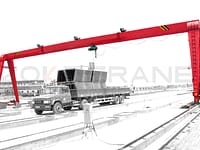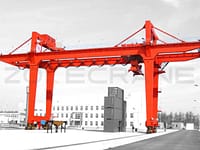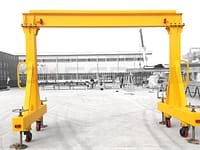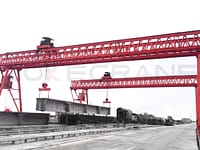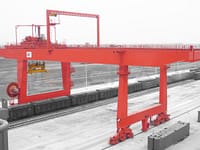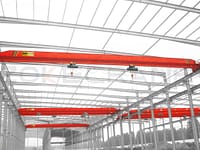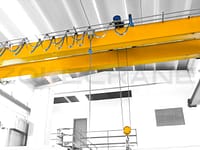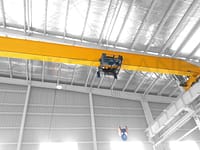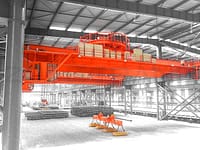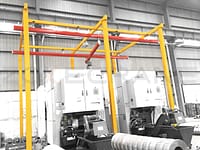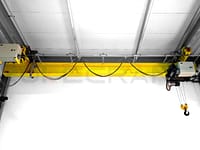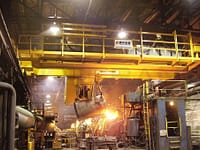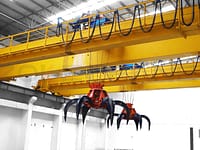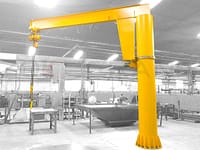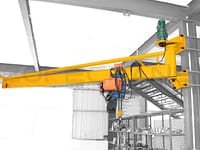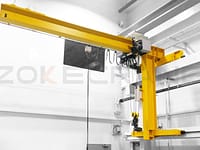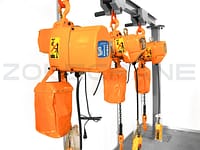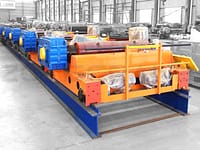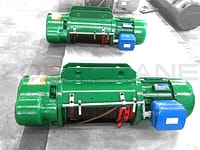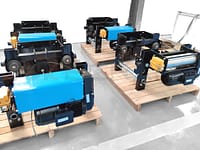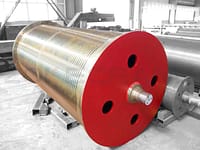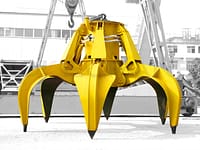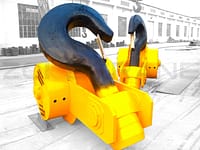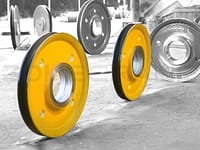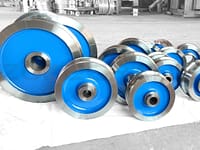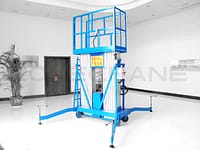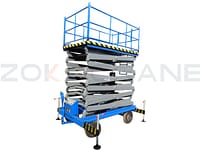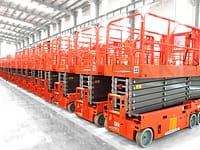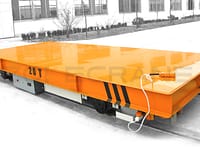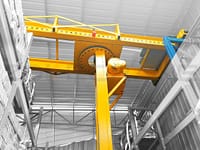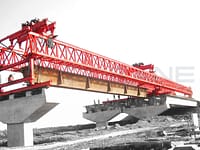Crane grabs, also known as material grabs or lifting grabs, are essential attachments used in various industries to lift and handle different types of materials. These specialized grabs are designed to provide a secure grip on specific loads, facilitating efficient material handling operations. In this article, we will explore and provide a comprehensive overview of the various types of crane grabs commonly used in industrial applications.
Clamshell Grab

A clamshell grab, also known as a clamshell bucket or simply a clamshell. The clamshell grab consists of two hinged shells or buckets that open and close vertically. It is primarily used for handling bulk materials such as sand, gravel, coal, or agricultural products. The clamshell grab's shells can be opened and closed to capture and release the material. This type of grab is widely used in construction, dredging, and cargo handling operations, enabling efficient loading and unloading of materials.
The clamshell grab consists of two hinged buckets or shells that open and close like a clam's shell. It is typically attached to the end of a crane, excavator, or other types of material handling machinery. The two shells are operated by hydraulic cylinders, which allow them to open and close, enabling the grab to pick up materials from the ground or stockpiles.

Here's how a clamshell grab generally works:
- Opening: The hydraulic cylinders extend, causing the two clamshell buckets to open up. This creates a large "mouth" that can be lowered onto the materials to be picked up.
- Descending: The operator uses the crane or excavator to lower the open clamshell grab onto the materials, allowing them to fall inside the bucket.
- Closing: Once the grab is in position, the hydraulic cylinders retract, closing the clamshell buckets around the materials, securing them inside.
- Lifting: With the materials securely held within the clamshell grab, the operator uses the crane or excavator to lift the grab and its contents from the ground.
- Transporting: The materials can then be transported to their desired location and released by opening the clamshell buckets again.

Clamshell grabs are especially useful in situations where bulk materials need to be loaded or unloaded quickly and efficiently. They are commonly used in construction projects, shipyards, ports, and other industrial settings that involve the movement of loose materials in large quantities.
The capacity of clamshell grabs can vary widely, ranging from a few cubic meters to several cubic meters, depending on the size and type of the equipment. They are essential tools in many industries, contributing to increased productivity and improved material handling processes.
Orange Peel Grab
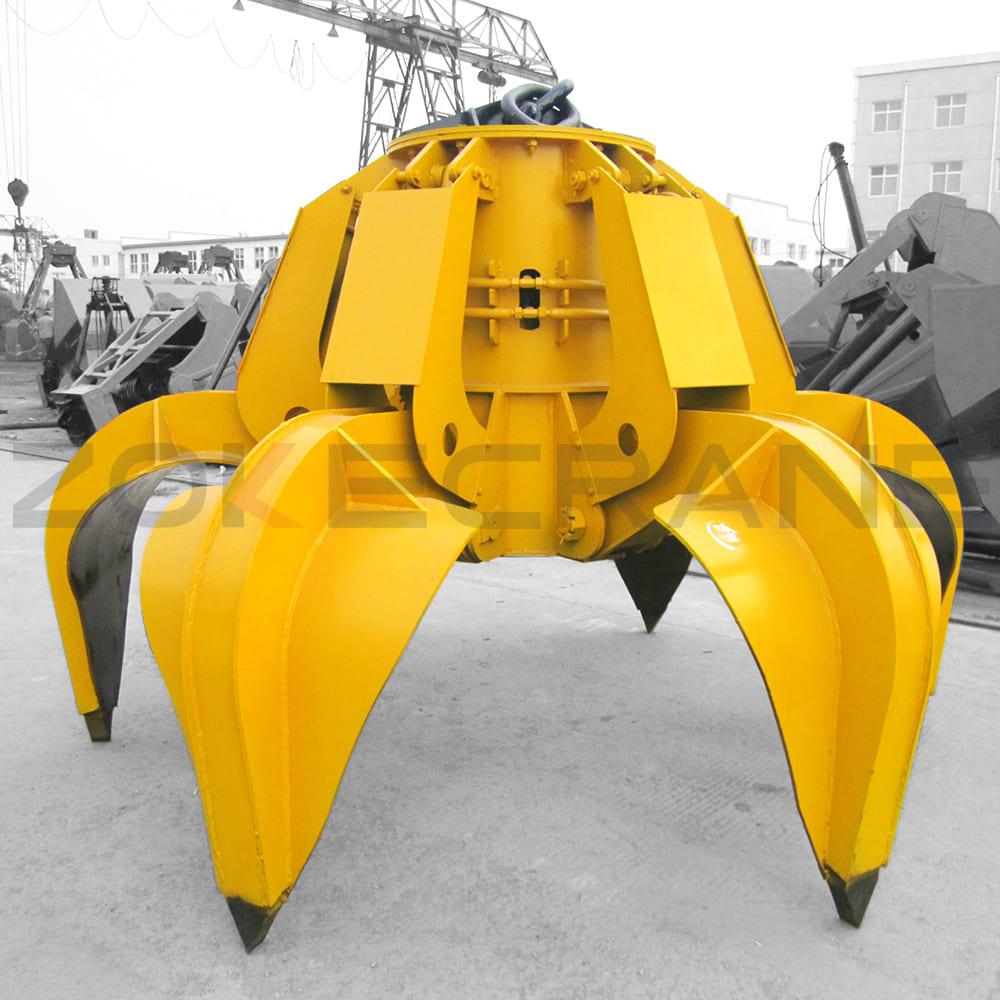
Orange peel grabs, also known as a Cactus Grab or Clamshell Grab with Orange Peel Petals, feature multiple hinged jaws that resemble the segments of an orange. These jaws open and close horizontally, providing an effective grip on irregularly shaped materials s such as scrap metal, industrial waste, rocks, and demolition debris. Orange peel grabs are commonly used in scrapyards, recycling facilities, and waste management operations. The design of the jaws allows for secure handling of uneven loads and enhances operational efficiency.

Construction and Design:
- The Orange Peel Grab consists of multiple individual curved or hinged "petals" that make up the grabbing mechanism. These petals are usually made of high-strength steel to withstand heavy-duty usage.
- The petals are arranged in a circular pattern, and they open and close horizontally, mimicking the movement of an orange peel when it is being opened or closed.
- The grabbing action is usually operated hydraulically, allowing precise control over the opening and closing of the petals.
Applications:
- Orange Peel Grabs are commonly used in scrap yards, recycling centers, and ports for loading and unloading various materials, including scrap metal, industrial waste, bulk rocks, and other irregularly shaped materials.
- They are particularly effective in handling bulky materials that may not be suitable for other types of grabs due to their irregular shapes and sizes.
- Orange Peel Grabs are also used in demolition projects to clear and transport debris efficiently.

Advantages:
- Versatility: The design of the Orange Peel Grab allows it to handle a wide range of irregularly shaped materials effectively.
- Secure grip: The multiple curved petals ensure a secure and balanced grip on the materials being handled, reducing the risk of spillage during transportation.
- Efficient operation: The hydraulic system enables smooth and precise opening and closing of the petals, enhancing the efficiency of loading and unloading operations.
- Enhanced productivity: The Orange Peel Grab can handle relatively large volumes of materials with each grab, improving overall productivity in material handling tasks.
Disadvantages:
- Limited to specific materials: The Orange Peel Grab is designed primarily for irregularly shaped bulk materials, and it may not be as efficient or suitable for handling other types of materials like sand, gravel, or loose soil.
- Maintenance: The multiple moving parts and hydraulic components of the grab require regular maintenance to ensure smooth operation and avoid downtime.
The Orange Peel Grab is a valuable tool in various industries where efficient handling of irregularly shaped bulk materials is essential. Its unique design and hydraulic operation make it well-suited for applications involving scrap handling, waste management, and demolition projects. However, it is essential to consider the specific material handling requirements and the condition of the materials to determine whether an Orange Peel Grab is the most suitable choice for a particular project.
Timber Grab

A Timber Grab, also known as a Log Grab or Lumber Grab, is a specialized type of crane grab used in the forestry and timber industry for handling logs and lumber. They typically feature curved arms with pointed or spiked ends that penetrate the wood to provide a secure grip. It is designed to securely grip and transport logs of various sizes and weights efficiently. Timber grabs come in various configurations, including single-arm or double-arm designs, depending on the size and weight of the logs being lifted, but most of them have a robust and rugged design to withstand the demanding conditions of timber handling. These grabs are extensively used in the forestry and wood processing industries.

Construction and Design:
- Timber grabs are typically made of high-strength steel to ensure durability and resistance to wear and tear.
- The grab's design may vary, but it usually consists of multiple jaws or tines that are operated hydraulically to open and close around the logs.
- The jaws are often equipped with sharp teeth or spikes to provide a secure grip on the timber.
Applications:
- Timber grabs are used in the forestry industry for loading and unloading logs onto trucks, trailers, or in timber yards and sawmills.
- They are commonly used in log handling operations at ports and harbors, where logs are transported via ships for export or import.
- Timber grabs are also employed in the construction industry when timber is used as a building material.

Advantages:
- Efficient log handling: Timber grabs enable quick and efficient loading and unloading of logs, reducing manual labor and improving productivity.
- Versatility: Timber grabs can handle logs of different sizes and shapes, making them suitable for various timber handling tasks.
- Secure grip: The sharp teeth or spikes on the jaws of the grab ensure a secure hold on the logs, reducing the risk of slippage during transportation.
- Reduces damage: By providing a secure grip and proper handling, timber grabs help minimize damage to the logs, preserving their quality.
Disadvantages:
- Limited to specific materials: Timber grabs are designed specifically for logs and lumber, and they may not be suitable for handling other types of materials.
- Maintenance: Regular maintenance is required to ensure the hydraulic components and gripping mechanisms operate smoothly and reliably.
Safety Considerations:
- Proper training is essential for the operators to ensure safe and efficient use of timber grabs.
- Operators should be aware of the load capacity of the grab and avoid exceeding it to prevent accidents.
- Timber grabs should be regularly inspected to identify any signs of wear or damage that could compromise safety.
Timber grabs play a crucial role in the forestry and timber industry, allowing for efficient and safe handling of logs and lumber. With their robust construction, secure grip, and versatility, timber grabs contribute to increased productivity and reduced manual labor in log handling operations. However, it's essential to adhere to safety guidelines and conduct regular maintenance to ensure the safe and effective use of timber grabs.
Container Grab

A Container Grab, also known as a Container Handling Grab or Container Spreader, is a specialized type of crane attachment used for loading and unloading standard ISO containers from ships, trucks, and other transport modes. Container grabs play a crucial role in port terminals, container yards, and intermodal facilities, where efficient container handling is essential.

Construction and Design:
- Container grabs are typically made of high-strength steel to withstand the heavy loads and harsh conditions in container handling operations.
- They consist of a frame with multiple twist-lock mechanisms that securely engage the corner castings of the container.
- The frame is attached to the crane's spreader bar, allowing it to be lifted and moved by the crane's hoisting system.
- Some container grabs may have adjustable arms or telescopic features to accommodate containers of different sizes.
Applications:
- Container grabs are used primarily in container terminals, ports, and intermodal facilities to load and unload containers onto and off ships and other transport vehicles, such as trucks and trains.
- They are commonly used for handling standard 20-foot and 40-foot ISO containers, as well as high-cube containers and other specialized container types.
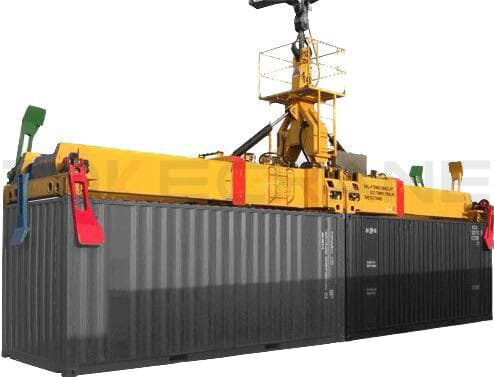
Advantages:
- Efficiency: Container grabs enable quick and efficient handling of containers, reducing the time required for loading and unloading operations.
- Versatility: They can handle different sizes and types of containers, allowing for flexible operations in container terminals.
- Safety: Container grabs are designed with secure twist-lock mechanisms, ensuring a stable and safe grip on the containers during lifting and transportation.
Disadvantages:
- Limited to container handling: Container grabs are specialized tools designed explicitly for container operations and may not be suitable for handling other types of cargo.
- Maintenance: Regular maintenance is required to ensure the proper functioning of the twist-lock mechanisms and other components of the container grab.
Safety Considerations:
- Proper training and certification are essential for crane operators and other personnel involved in container handling operations.
- Container grabs should be inspected regularly to identify any signs of wear, damage, or malfunction that could compromise safety.
- Safe working load limits should always be adhered to when using container grabs to avoid accidents and equipment damage.
Container grabs are indispensable tools in the container shipping and logistics industry, enabling the efficient and safe handling of standard ISO containers. With their robust design, secure twist-lock mechanisms, and adaptability to different container sizes, container grabs contribute to smooth and streamlined operations in container terminals and ports worldwide. Proper maintenance and adherence to safety guidelines are crucial to ensuring the safe and effective use of container grabs in container handling operations.
Magnetic Grab

A Magnetic Grab, also known as a Magnetic Lifting Grab or Electromagnetic Grab, is a specialized type of crane grab used for handling ferromagnetic materials, such as iron, steel, and other magnetic metals. It utilizes an electromagnetic system to attract and lift ferrous objects, these grabs eliminate the need for additional hooks or clamps, as the magnetic force securely holds the material, making it particularly useful in metal recycling, scrap yards, and industrial material handling applications.
Construction and Design:
- The Magnetic Grab consists of a heavy-duty frame and an electromagnet assembly.
- The electromagnet is typically made of ferromagnetic materials and wound with coils of copper wire to create an electromagnetic field.
- The frame is usually equipped with a hook or a spreader bar, allowing it to be attached to the crane's hoisting system.
How it works:
- When an electric current flows through the coils of the electromagnet, it generates a magnetic field that attracts ferrous materials in its vicinity.
- The magnetic force created by the electromagnet allows the grab to securely lift and transport ferrous objects, such as metal plates, bars, sheets, and scrap metal.

Applications:
- Magnetic Grabs are commonly used in metal recycling facilities to efficiently handle and load scrap metal into processing machines or containers.
- They are employed in steel mills and metal fabrication plants for moving steel plates and other magnetic metals during the manufacturing process.
- Magnetic Grabs find application in salvage operations to retrieve sunken or submerged ferrous objects from water bodies.
Advantages:
- Efficient handling: Magnetic Grabs can lift multiple ferrous objects simultaneously, allowing for quick and efficient material handling.
- Reduced labor: The use of Magnetic Grabs eliminates or reduces the need for manual labor in handling ferrous materials, improving overall productivity and safety.
- Precise positioning: The electromagnetic system allows for precise control over the attraction and detachment of ferrous objects, enabling accurate placement of materials.
Disadvantages:
- Limited to ferrous materials: Magnetic Grabs can only handle ferromagnetic materials and are not suitable for non-magnetic materials like aluminum, copper, or plastics.
- Power supply requirement: Since the grab relies on an electromagnetic system, it requires a stable and sufficient power supply to operate effectively.
Safety Considerations:
- Operators should be trained in the proper use and handling of Magnetic Grabs to prevent accidents and ensure safe operations.
- Adequate safety precautions must be taken when working with heavy or irregularly shaped ferrous objects to prevent shifting or unexpected movements during lifting.
Magnetic Grabs are valuable tools in industries dealing with ferrous materials, providing efficient and reliable handling solutions. With their ability to attract and lift magnetic metals, they streamline material handling processes, reduce labor requirements, and contribute to improved productivity. However, their limitations in handling non-ferrous materials and the need for a stable power supply should be considered when determining their suitability for specific material handling tasks. Regular maintenance and adherence to safety guidelines are essential for the safe and effective use of Magnetic Grabs in various industrial applications.
Grapple Grab

A Grapple Grab, also known as a Grapple or Grapple Bucket, is a versatile type of crane grab used for handling various types of materials, including rocks, wood, scrap metal, construction debris, and other bulk materials. Grapple grabs are designed with a set of jaws or tines that can open and close to grip and lift the materials securely. They are widely used in construction, forestry, waste management, demolition, and material handling industries.
Construction and Design:
- Grapple grabs come in different designs and configurations, depending on the specific application and the type of materials to be handled.
- The jaws or tines of the grapple are typically made of high-strength steel to withstand the rugged conditions of material handling operations.
- Grapple grabs can be operated manually or hydraulically, depending on the size and purpose of the grab.
Types of Grapple Grabs:
- Log Grapple: Designed for handling logs and timber in forestry and lumber industries. It has curved tines to securely grip and lift logs of various sizes.
- Rock Grapple: Suitable for handling rocks, stones, and large debris in construction and excavation projects. It typically has flat and sturdy tines for effective rock handling.
- Scrap Grapple: Specifically designed for handling scrap metal in recycling facilities and scrap yards. It has strong and sharp tines to securely grip and lift metal pieces.
- Demolition Grapple: Used in demolition projects to clear debris and handle demolition waste. It has rugged construction and powerful gripping capabilities.

Applications:
- Grapple grabs are commonly used in forestry and logging operations for lifting and transporting logs and timber.
- In construction and demolition projects, grapple grabs are used to handle rocks, debris, and other materials.
- In waste management facilities, grapple grabs are used for sorting and moving bulky waste materials.
- Grapple grabs are also employed in recycling centers for handling scrap metal and other recyclables.
Advantages:
- Versatility: Grapple grabs can handle a wide range of materials, making them suitable for various applications.
- Efficiency: They allow for quick and easy loading, unloading, and sorting of materials, improving overall productivity.
- Secure grip: The strong and adjustable jaws of the grapple ensure a secure hold on the materials during lifting and transportation.
Disadvantages:
- Limited to bulk materials: Grapple grabs may not be as effective for handling loose, granular materials like sand or small-sized materials.
- Maintenance: Regular maintenance is required to ensure the smooth operation of the grab and prevent wear and tear.
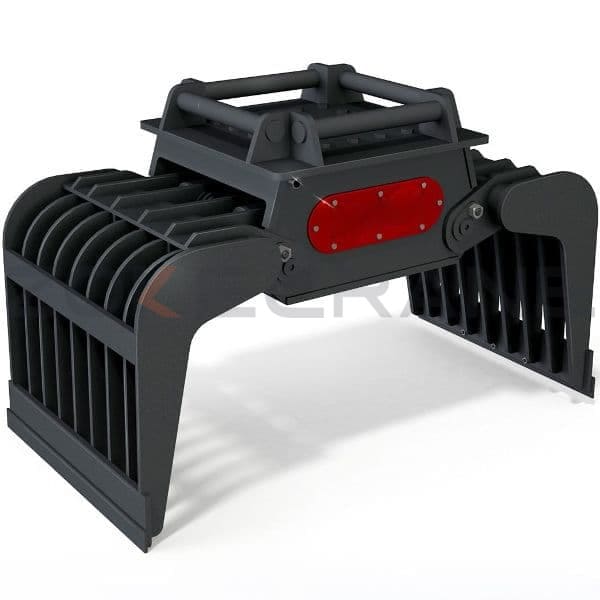
Safety Considerations:
- Proper training and certification of crane operators are essential to ensure safe and efficient use of grapple grabs.
- Operators should be aware of the load capacity and limitations of the grab to avoid overloading and potential accidents.
Grapple grabs are versatile and indispensable tools in various industries that require efficient material handling. Whether it's logs, rocks, scrap metal, or construction debris, grapple grabs provide a secure and efficient way to lift and transport bulk materials. The specific design and type of grapple grab used depend on the nature of the materials being handled and the requirements of the application. Regular maintenance and adherence to safety guidelines are crucial to ensuring the safe and effective use of grapple grabs in material handling operations.
Conclusion:
Understanding the different types of crane grabs is essential for selecting the appropriate grab for specific material handling needs. Each type of grab offers distinct features and advantages for lifting and manipulating different types of loads. Whether it's handling bulk materials, logs, containers, or specialized materials like scrap metal, choosing the right grab ensures efficient and safe material handling operations. Crane grabs play a crucial role in enhancing productivity and optimizing workflows across various industries, making them indispensable tools for modern material handling applications.
